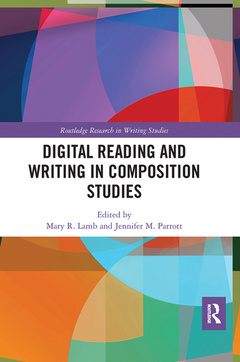Digital Reading and Writing in Composition Studies Routledge Research in Writing Studies Series
Coordonnateurs : Lamb Mary R., Parrott Jennifer M.

As digital reading has become more productive and active, the lines between reading and writing become more blurred. This book offers both an exploration of collaborative reading and pedagogical strategies for teaching reading and writing that reflect the realities of digital literacies.
This edited scholarly collection offers strategies for teaching reading and writing that highlight the possibilities, opportunities, and complexities of digital literacies. Part 1 explores reading and writing that happen digitally and offers frameworks for thinking about this process. Part 2 focuses on strategies for the classroom by applying reading theories, design principles, and rhetorical concepts to instruction. Part 3 introduces various disciplinary implications for this blended approach to writing instruction. What is emerging is new theories and practices of reading in both print and digital spaces?theories that account for how diverse student readers encounter and engage digital texts. This collection contributes to this work by offering strategies for sustaining reading and cultivating writing in this landscape of changing digital literacies.
The book is essential for the professional development of beginning teachers, who will appreciate the historical and bibliographic overview as well as classroom strategies, and for busy veteran teachers, who will gain updated knowledge and a renewed commitment to teaching an array of literacy skills. It will be ideal for graduate seminars in composition theory and pedagogy, both undergraduate and graduate; and teacher education courses, and will be key reading for scholars in rhetoric and composition interested in composition history, assessment, communication studies, and literature pedagogy.
Part 1 Collaborative Reading: Approaches to Reading in Crowded Digital Spaces
1 How Digital Writing and Design Can Sustain Reading, or Prezi is not just for Presentations—Well, Now, Maybe It Is
2 Developing Information Literacy through Critical Reading and Writing
3 Arguing with Ourselves: Rhetorical Reading as/of Algorithms on the Web
4 A Difference in Delivery: Reading Classroom Technology Practices
Part 2 Teaching Writing and Reading in Digital Spaces
5 The Past, Present, and Future of Social Annotation
6 Teaching Writing and Reading in Digital Spaces through the Rhetoric of Social Commentary
7Annotating with Google Docs: Bridging Collaborative Digital Reading and Writing in the Composition Classroomss
8 Situating Design: Cultivating Digital Readers and Writers in the Composition
Classroom
9 Reading, Writing, Produsing: Fostering Students Authors in the Public Space
10 Reorienting Relationships to Reading by Dwelling in Our Discomfort 11 Clip, Tag, Annotate: Active Reading Practices for Digital Texts
Part 3 Implications and Institutional Contexts
12 Reading and Writing Digital Contexts across Campus: From FYC and FYE to ME to CE
13 Trending Information: Mapping Students’ Information Literacies against WPA Learning Outcomes in First-Year Writing
14 New Assessments for New Reading: An Evidence Based Approach
Afterword
Mary R. Lamb is Associate Professor in the Department of English at Clayton State University, USA
Date de parution : 09-2020
15.2x22.9 cm
Date de parution : 03-2019
15.2x22.9 cm
Thèmes de Digital Reading and Writing in Composition Studies :
Mots-clés :
LMS Site; Urban Public Research University; writing studies; Michigan State University; rhetoric; Syllabus Policies; literacy; Interactive Meaning Makers; collaborative; Key Words; pedagogy; Digital Reading; teacher development; Information Literacy; writing program; Writing Program Administrator; theory; Digital Texts; new media; Evidence Based Assessment; multimodal; IL Instruction; research; Digital Writing; online; Information Literacy Skills; Learning Information Literacy; College Writing Classrooms; Composition Classroom; IL Test; IL Issue; Academic Critical Literacy; Reading Technology; Digital Notebook; Google Docs; Multimodal Patterns; Book Traces



